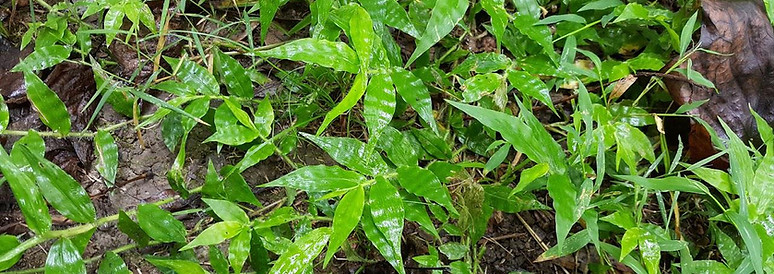

Newsletters
Am I allowed to use the login credentials of
another person to access the database?
Alligatorweed
(Alternanthera philoxeroides)
Found an invasive species? Register for a free login account, or submit a public report.

Photo credit: Andrew Rohrbaugh (DCNR Bureau of Forestry)
Wavyleaf Basketgrass
(Oplismenus hirtellus spp. undulatifolius)
Report this Species!
If you believe you have found this species anywhere in Pennsylvania, please report your findings to iMapInvasives by submitting an observation record.
-
Already a registered user? Login to submit your observation.
-
Not a registered user? Submit a public report.
-
Watch our training video to learn how to submit an observation record (as a registered user).
Species at a Glance
Wavyleaf basketgrass is an introduced subspecies of the native basketgrass (O. hirtellus (L.) P. Beauv.). It is a fast-spreading, perennial, understory grass that forms dense stands that can crowd out native herbaceous plants and threaten the deciduous forests of eastern North America.
Identification
Similar Species
While wavyleaf basketgrass resembles Japanese stilt grass (Microstegium vimineum), these species differ in that the leaves of Japanese stiltgrass have a silvery row of hairs running down the midvein and end in a blunt gradual point. Wavyleaf basketgrass leaves are rippled across their width and end with an elongated sharp tip.
Habitat
Wavyleaf basketgrass is a shade tolerant species that avoids sunny environments. It is mainly found in shaded, moist, deciduous forests.
Spread
Wavyleaf basketgrass spreads quickly through rhizomes and seeds. The sticky substance on the seeds allows them to adhere to passing animals, people, or vehicles, easily spreading to new locations.
Distribution
Native to Europe and Asia, it’s unclear how wavyleaf basketgrass was first introduced to the United States; however, it’s possible it was through contamination of hanging baskets. It was first found in Howard County Maryland in 1996. In 2000, it was found growing along a stream in Baltimore County, Maryland. Documented locations have also been found in Virginia.
Note: Distribution data for this species may have changed since the publication of the Mid-Atlantic Field Guide to Aquatic Invasive Species (2016), the source of information for this description.
Environmental Impacts
This species can completely cover the forest floor, providing competition against native forest species. With the decrease in plant diversity, wavyleaf basketgrass also provides very little wildlife value. Because it is still relatively new in the United States, its ecological impacts are mostly unknown.
Video
Note
Information for this species profile comes from the Mid-Atlantic Field Guide to Aquatic Invasive Species (2016).